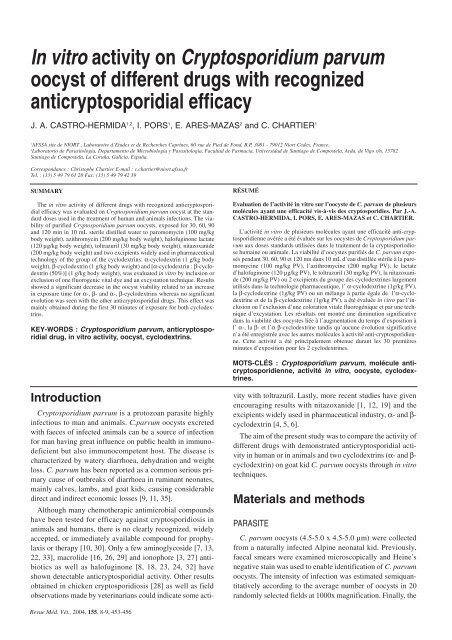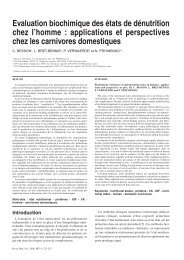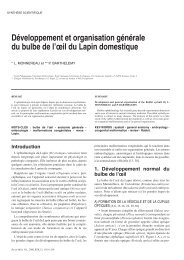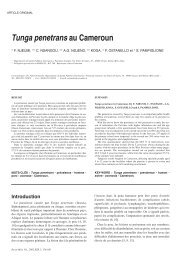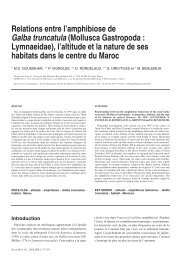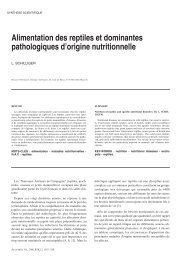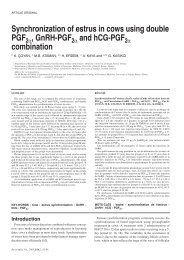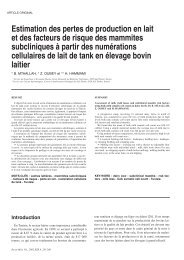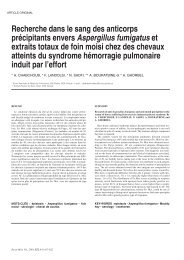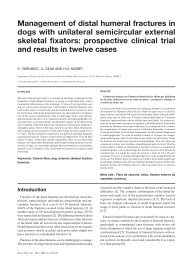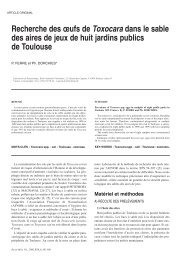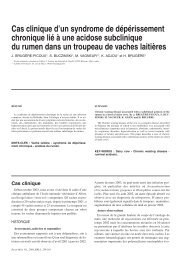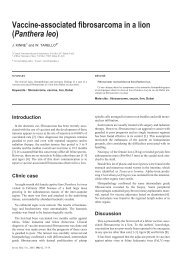In vitro activity on Cryptosporidium parvum oocyst of ... - ResearchGate
In vitro activity on Cryptosporidium parvum oocyst of ... - ResearchGate
In vitro activity on Cryptosporidium parvum oocyst of ... - ResearchGate
Create successful ePaper yourself
Turn your PDF publications into a flip-book with our unique Google optimized e-Paper software.
<str<strong>on</strong>g>In</str<strong>on</strong>g> <str<strong>on</strong>g>vitro</str<strong>on</strong>g> <str<strong>on</strong>g>activity</str<strong>on</strong>g> <strong>on</strong> <strong>Cryptosporidium</strong> <strong>parvum</strong><br />
<strong>oocyst</strong> <strong>of</strong> different drugs with recognized<br />
anticryptosporidial efficacy<br />
J. A. CASTRO-HERMIDA 1,2 , I. PORS 1 , E. ARES-MAZAS 2 and C. CHARTIER 1<br />
1<br />
AFSSA site de NIORT , Laboratoire d’Etudes et de Recherches Caprines, 60 rue de Pied de F<strong>on</strong>d, B.P. 3081 - 79012 Niort Cedex, France.<br />
2<br />
Laboratorio de Parasitologia, Departamento de Microbiologia y Parasitologia, Facultad de Farmacia, Universidad de Santiago de Compostela, Avda. de Vigo s/n, 15782<br />
Santiago de Compostela, La Coruña, Galicia, España.<br />
Corresp<strong>on</strong>dance : Christophe Chartier E-mail : c.chartier@niort.afssa.fr<br />
Tel. : (33) 5 49 79 61 28 Fax: (33) 5 49 79 42 19<br />
SUMMARY<br />
The in <str<strong>on</strong>g>vitro</str<strong>on</strong>g> <str<strong>on</strong>g>activity</str<strong>on</strong>g> <strong>of</strong> different drugs with recognized anticryptosporidial<br />
efficacy was evaluated <strong>on</strong> <strong>Cryptosporidium</strong> <strong>parvum</strong> <strong>oocyst</strong> at the standard<br />
doses used in the treatment <strong>of</strong> human and animals infecti<strong>on</strong>s. The viability<br />
<strong>of</strong> purified <strong>Cryptosporidium</strong> <strong>parvum</strong> <strong>oocyst</strong>s, exposed for 30, 60, 90<br />
and 120 min in 10 mL sterile distilled water to paromomycin (100 mg/kg<br />
body weight), azithromycin (200 mg/kg body weight), hal<strong>of</strong>ugin<strong>on</strong>e lactate<br />
(120 µg/kg body weight), toltrazuril (30 mg/kg body weight), nitazoxanide<br />
(200 mg/kg body weight) and two excipients widely used in pharmaceutical<br />
technology <strong>of</strong> the group <strong>of</strong> the cyclodextrins: α-cyclodextrin (1 g/kg body<br />
weight), β-cyclodextrin (1 g/kg body weight) and [α-cyclodextrin : β-cyclodextrin<br />
(50%)] (1 g/kg body weight), was evaluated in <str<strong>on</strong>g>vitro</str<strong>on</strong>g> by inclusi<strong>on</strong> or<br />
exclusi<strong>on</strong> <strong>of</strong> <strong>on</strong>e fluorogenic vital dye and an excystati<strong>on</strong> technique. Results<br />
showed a significant decrease in the <strong>oocyst</strong> viability related to an increase<br />
in exposure time for α-, β- and α-, β-cyclodextrins whereas no significant<br />
evoluti<strong>on</strong> was seen with the other anticryptosporidial drugs. This effect was<br />
mainly obtained during the first 30 minutes <strong>of</strong> exposure for both cyclodextrins.<br />
KEY-WORDS : <strong>Cryptosporidium</strong> <strong>parvum</strong>, anticryptosporidial<br />
drug, in <str<strong>on</strong>g>vitro</str<strong>on</strong>g> <str<strong>on</strong>g>activity</str<strong>on</strong>g>, <strong>oocyst</strong>, cyclodextrins.<br />
RÉSUMÉ<br />
Evaluati<strong>on</strong> de l’activité in <str<strong>on</strong>g>vitro</str<strong>on</strong>g> sur l’<strong>oocyst</strong>e de C. <strong>parvum</strong> de plusieurs<br />
molécules ayant une efficacité vis-à-vis des cryptosporidies. Par J.-A.<br />
CASTRO-HERMIDA, I. PORS, E. ARES-MAZAS et C. CHARTIER.<br />
L’activité in <str<strong>on</strong>g>vitro</str<strong>on</strong>g> de plusieurs molécules ayant une efficacité anti-cryptosporidienne<br />
avérée a été évaluée sur les <strong>oocyst</strong>es de <strong>Cryptosporidium</strong> <strong>parvum</strong><br />
aux doses standards utilisées dans le traitement de la cryptosporiodiose<br />
humaine ou animale. La viabilité d’<strong>oocyst</strong>es purifiés de C. <strong>parvum</strong> exposés<br />
pendant 30, 60, 90 et 120 mn dans 10 mL d’eau distillée stérile à la paromomycine<br />
(100 mg/kg PV), l’azithromycine (200 mg/kg PV), le lactate<br />
d’hal<strong>of</strong>ugin<strong>on</strong>e (120 µg/kg PV), le toltrazuril (30 mg/kg PV), la nitazoxanide<br />
(200 mg/kg PV) ou 2 excipients du groupe des cyclodextrines largement<br />
utilisés dans la technologie pharmaceutique, l’ α-cyclodextrine (1g/kg PV),<br />
la β-cyclodextrine (1g/kg PV) ou un mélange à partie égale de l’α-cyclodextrine<br />
et de la β-cyclodextrine (1g/kg PV), a été évaluée in <str<strong>on</strong>g>vitro</str<strong>on</strong>g> par l’inclusi<strong>on</strong><br />
ou l’exclusi<strong>on</strong> d’une colorati<strong>on</strong> vitale fluorogénique et par une technique<br />
d’excystati<strong>on</strong>. Les résultats <strong>on</strong>t m<strong>on</strong>tré une diminuti<strong>on</strong> significative<br />
dans la viabilité des <strong>oocyst</strong>es liée à l’augmentati<strong>on</strong> du temps d’expositi<strong>on</strong> à<br />
l’ α-, la β- et l’α β-cyclodextrine tandis qu’aucune évoluti<strong>on</strong> significative<br />
n’a été enregistrée avec les autres molécules à activité anti-cryptosporidienne.<br />
Cette activité a été principalement obtenue durant les 30 premières<br />
minutes d’expositi<strong>on</strong> pour les 2 cyclodextrines.<br />
MOTS-CLÉS : <strong>Cryptosporidium</strong> <strong>parvum</strong>, molécule anticryptosporidienne,<br />
activité in <str<strong>on</strong>g>vitro</str<strong>on</strong>g>, <strong>oocyst</strong>e, cyclodextrines.<br />
<str<strong>on</strong>g>In</str<strong>on</strong>g>troducti<strong>on</strong><br />
<strong>Cryptosporidium</strong> <strong>parvum</strong> is a protozoan parasite highly<br />
infectious to man and animals. C.<strong>parvum</strong> <strong>oocyst</strong>s excreted<br />
with faeces <strong>of</strong> infected animals can be a source <strong>of</strong> infecti<strong>on</strong><br />
for man having great influence <strong>on</strong> public health in immunodeficient<br />
but also immunocompetent host. The disease is<br />
characterized by watery diarrhoea, dehydrati<strong>on</strong> and weight<br />
loss. C. <strong>parvum</strong> has been reported as a comm<strong>on</strong> serious primary<br />
cause <strong>of</strong> outbreaks <strong>of</strong> diarrhoea in ruminant ne<strong>on</strong>ates,<br />
mainly calves, lambs, and goat kids, causing c<strong>on</strong>siderable<br />
direct and indirect ec<strong>on</strong>omic losses [9, 11, 35].<br />
Although many chemotherapic antimicrobial compounds<br />
have been tested for efficacy against cryptosporidiosis in<br />
animals and humans, there is no clearly recognized, widely<br />
accepted, or immediately available compound for prophylaxis<br />
or therapy [10, 30]. Only a few aminoglycoside [7, 13,<br />
22, 33], macrolide [16, 26, 29] and i<strong>on</strong>ophore [3, 27] antibiotics<br />
as well as hal<strong>of</strong>ugin<strong>on</strong>e [8, 18, 23, 24, 32] have<br />
shown detectable anticryptosporidial <str<strong>on</strong>g>activity</str<strong>on</strong>g>. Other results<br />
obtained in chicken cryptosporidiosis [28] as well as field<br />
observati<strong>on</strong>s made by veterinarians could indicate some <str<strong>on</strong>g>activity</str<strong>on</strong>g><br />
with toltrazuril. Lastly, more recent studies have given<br />
encouraging results with nitazoxanide [1, 12, 19] and the<br />
excipients widely used in pharmaceutical industry, α- and β-<br />
cyclodextrin [4, 5, 6].<br />
The aim <strong>of</strong> the present study was to compare the <str<strong>on</strong>g>activity</str<strong>on</strong>g> <strong>of</strong><br />
different drugs with dem<strong>on</strong>strated anticryptosporidial <str<strong>on</strong>g>activity</str<strong>on</strong>g><br />
in human or in animals and two cyclodextrins (α- and β-<br />
cyclodextrin) <strong>on</strong> goat kid C. <strong>parvum</strong> <strong>oocyst</strong>s through in <str<strong>on</strong>g>vitro</str<strong>on</strong>g><br />
techniques.<br />
Materials and methods<br />
PARASITE<br />
C. <strong>parvum</strong> <strong>oocyst</strong>s (4.5-5.0 x 4.5-5.0 µm) were collected<br />
from a naturally infected Alpine ne<strong>on</strong>atal kid. Previously,<br />
faecal smears were examined microscopically and Heine’s<br />
negative stain was used to enable identificati<strong>on</strong> <strong>of</strong> C. <strong>parvum</strong><br />
<strong>oocyst</strong>s. The intensity <strong>of</strong> infecti<strong>on</strong> was estimated semiquantitatively<br />
according to the average number <strong>of</strong> <strong>oocyst</strong>s in 20<br />
randomly selected fields at 1000x magnificati<strong>on</strong>. Finally, the<br />
Revue Méd. Vét., 2004, 155, 8-9, 453-456
454 CASTRO-HERMIDA (J.-A.) AND COLLABORATORS<br />
selected faecal sample presented a severe intensity <strong>of</strong> infecti<strong>on</strong><br />
(>10 <strong>oocyst</strong>s). Oocysts were c<strong>on</strong>centrated and purified<br />
as previously described by Lorenzo et al. [21]. Briefly, fecal<br />
material was mixed with 0.04 M phosphate-buffered saline<br />
(PBS), pH 7.2 and passed through sieves (mesh size 45 µm).<br />
The resulting fluid was resuspended 2:1 (v/v) with diethyl<br />
ether into 50 ml c<strong>on</strong>ical centrifuge tubes, shaken vigorously<br />
for 30 s and centrifuged at 1000 g for 5 min. The top three<br />
layers were decanted. This step was repeated until the sediment<br />
was free <strong>of</strong> lipids. After several washings the sediment<br />
was resuspended in 1 ml <strong>of</strong> PBS and overlaid <strong>on</strong> a Percoll®<br />
(Sigma Chemical Co., St. Lousis, MO) disc<strong>on</strong>tinuous density<br />
gradient c<strong>on</strong>sisting in four 2.5 ml layers with densities <strong>of</strong><br />
1.13, 1.09, 1.05 and 1.01 g/mL. The gradients were centrifuged<br />
at 650 g for 15 min at 4°C and the <strong>oocyst</strong>s were harvested<br />
as a clearly defined band between 1.05 and 1.09 g/mL<br />
Percoll® layer. The <strong>oocyst</strong>s were washed three times in PBS<br />
and resuspended 1:1 (v/v) in a 5% potassium dichromate<br />
soluti<strong>on</strong> and stored at 4°C until viability assays were performed<br />
(no later than 1 week). Previously to these assays,<br />
<strong>oocyst</strong>s were washed three times at 4°C in PBS in order to<br />
remove the potassium dichromate soluti<strong>on</strong>. The number <strong>of</strong><br />
<strong>oocyst</strong>s present in 1 mL <strong>of</strong> suspensi<strong>on</strong> was counted in a<br />
modified Neubauer hemacytometer after mixing 0.2 ml with<br />
0.8 ml <strong>of</strong> malachite green (malachite green, 0.16 g; distilled<br />
water, 100 mL).<br />
IN VITRO VIABILITY ASSAYS<br />
Purified <strong>oocyst</strong>s were exposed for 30, 60, 90 and 120 min<br />
to paromomycin (100 mg/kg body weight, Sigma Chemical<br />
Co., St. Lousis, MO), azithromycin (200 mg/kg body weight,<br />
Zithromax®, Pfizer), hal<strong>of</strong>ugin<strong>on</strong>e lactate (120 µg/kg body<br />
weight, Halocur®, <str<strong>on</strong>g>In</str<strong>on</strong>g>tervet), toltrazuril (30 mg/kg body<br />
weight, Baycox®, Bayer), nitazoxanide (200 mg/kg body<br />
weight, Nodik®, Pharmanova, divisi<strong>on</strong> Unipharm-<br />
<str<strong>on</strong>g>In</str<strong>on</strong>g>ternati<strong>on</strong>al S.A.), α-cyclodextrin (1g/kg body weight,<br />
Wacker-Chemie GmbH), β-cyclodextrin (1 g/kg body<br />
weight, Roquette-Laisa, Spain) and [α-cyclodextrin : β-<br />
cyclodextrin (50%)] (1 g/kg body weight). Each drug was<br />
tested in 10 mL sterile distilled water at 20°C in a test tube (2<br />
replicates : assay 1 and assay 2) and shaken (70 rpm) ; then,<br />
the <strong>oocyst</strong>s were washed twice and counted as described previously<br />
Lorenzo et al. [21].<br />
<str<strong>on</strong>g>In</str<strong>on</strong>g>clusi<strong>on</strong>/exclusi<strong>on</strong> <strong>of</strong> fluorogenic PI vital dye<br />
This technique is based <strong>on</strong> the inclusi<strong>on</strong> or exclusi<strong>on</strong> <strong>of</strong><br />
propidium iodide (PI) fluorogenic vital dye and described<br />
previously by Campbell et al. [2]. Briefly, approximately<br />
2x10 6 treated and untreated <strong>oocyst</strong>s were resuspended to 100<br />
µL in Hanks balanced salt soluti<strong>on</strong> (HBSS) and incubated<br />
simultaneously with 10 µL <strong>of</strong> PI working soluti<strong>on</strong> (1 mg/mL<br />
in 0.1 M PBS, pH 7.2) at 37°C for the length <strong>of</strong> time optimal<br />
for producing maximal dye uptake (2 h). Oocysts were<br />
washed twice in HBSS before being observed by fluorescence<br />
microscopy. Proporti<strong>on</strong> <strong>of</strong> PI-positive (PI+: permeable<br />
and dead) and PI-negative (PI-: impermeables and viable at<br />
assay) <strong>oocyst</strong>s were quantified by counting more than 100<br />
<strong>oocyst</strong>s in each sample.<br />
Excystati<strong>on</strong> technique<br />
A technique <strong>of</strong>fering approximately 98% <strong>of</strong> excystati<strong>on</strong> in<br />
untreated <strong>oocyst</strong>s was used [31]. Treated and untreated<br />
<strong>oocyst</strong>s numbering 2x10 6 were resuspended in 10 mL <strong>of</strong><br />
0.9% NaCl and 0.5% (w/v) pepsin (62 units/mg solid) and 70<br />
µL <strong>of</strong> c<strong>on</strong>centrated HCl were added. The reactants were<br />
mixed thoroughly prior to incubati<strong>on</strong> at 37°C for 30 min.<br />
After this preincubati<strong>on</strong> treatment, the mixture was neutralized<br />
with 2.2% HNaCO 3 . Then, 0.022 g <strong>of</strong> sodium taurocholate<br />
and 0.004 g bovine trypsin were added and incubated at<br />
37°C for 120 min and the suspensi<strong>on</strong> was fixed by additi<strong>on</strong><br />
<strong>of</strong> 3% glutaraldehyde. Percentage excystati<strong>on</strong> was calculated<br />
by scanning 10 µL aliquots <strong>of</strong> suspensi<strong>on</strong> under phase<br />
c<strong>on</strong>trast microscopy and counting all the intact and empty<br />
<strong>oocyst</strong>s seen in a successi<strong>on</strong> <strong>of</strong> random fields. Excystati<strong>on</strong><br />
percentage was given by: (number <strong>of</strong> empty <strong>oocyst</strong>s/total<br />
<strong>oocyst</strong>s)x100.<br />
STATISTICAL ANALYSIS<br />
The data were analyzed by a test <strong>of</strong> comparis<strong>on</strong> <strong>of</strong> proporti<strong>on</strong>s<br />
(Statitcf® Ver. 5) and a Analysis <strong>of</strong> Variance ANOVA<br />
(Systat® Ver. 9.01 for Windows®).<br />
Results<br />
The results <strong>of</strong> in <str<strong>on</strong>g>vitro</str<strong>on</strong>g> viability assay for <strong>oocyst</strong>s <strong>of</strong> C. <strong>parvum</strong><br />
treated with different drugs and two excipients <strong>of</strong> the<br />
group <strong>of</strong> the cyclodextrins for different times (30, 60, 90 and<br />
120 min) dem<strong>on</strong>strated a general trend with a decrease in the<br />
percentage <strong>of</strong> excystati<strong>on</strong> and an increase in the percentage<br />
<strong>of</strong> dead <strong>oocyst</strong>s (PI+), which was related to the increase in<br />
exposure time for each <strong>of</strong> the evaluated products (Table I).<br />
Nevertheless, the decrease <strong>of</strong> viability throughout the exposure<br />
time was significant (P < 0.05) <strong>on</strong>ly with α-, β- and αβcyclodextrins.<br />
<str<strong>on</strong>g>In</str<strong>on</strong>g> the c<strong>on</strong>trol assays, the percentage <strong>of</strong> viable<br />
<strong>oocyst</strong>s, at the maximum <strong>of</strong> exposure time, remained 98%<br />
and 99% for the inclusi<strong>on</strong>/exclusi<strong>on</strong> <strong>of</strong> PI fluorogenic vital<br />
dye and excystati<strong>on</strong> techniques respectively. The decrease in<br />
<strong>oocyst</strong> viability with cyclodextrins was observed during the<br />
first 30 minutes <strong>of</strong> exposure (P < 0.05).<br />
Discussi<strong>on</strong><br />
The results obtained in the present study dem<strong>on</strong>strated a<br />
high proporti<strong>on</strong> <strong>of</strong> n<strong>on</strong>viable <strong>oocyst</strong>s ranging from 30 to 40 %<br />
when in c<strong>on</strong>tact with α, β or both cyclodextrins. <str<strong>on</strong>g>In</str<strong>on</strong>g> c<strong>on</strong>trast,<br />
the viability <strong>of</strong> <strong>oocyst</strong>s did not seem significantly affected by<br />
the other anticryptosporidial drugs i.e., paromomycin, azithromycin,<br />
hal<strong>of</strong>ugin<strong>on</strong>e lactate, toltrazuril and nitazoxanide.<br />
The mechanisms <strong>of</strong> inhibiti<strong>on</strong> <strong>of</strong> C. <strong>parvum</strong> infecti<strong>on</strong> by<br />
the n<strong>on</strong>absorbable cyclodextrins are still unknown. The<br />
molecular structure <strong>of</strong> cyclodextrins, which approximates a<br />
truncated c<strong>on</strong>e or torus, generates a hydrophilic exterior surface<br />
and a n<strong>on</strong>polar cavity interior. As such, cyclodextrins<br />
can interact with appropriately sized molecules to result in<br />
the formati<strong>on</strong> <strong>of</strong> inclusi<strong>on</strong> complexes. Therefore, it is possible<br />
that cyclodextrins interacted with hydrophobic mole-<br />
Revue Méd. Vét., 2004, 155, 8-9, 453-456
IN VITRO ACTIVITY ON CRYPTOSPORIDIUM PARVUM OOCYST 455<br />
cules at the level <strong>of</strong> the <strong>oocyst</strong> wall. Moreover, the number <strong>of</strong><br />
glucose units in the cyclodextrin determines the size <strong>of</strong> the<br />
hydrophobic pocket and, in turn, which lipids the cyclodextrin<br />
solubilizes [15, 20, 25]. When both cyclodextrins were<br />
mixed in equal proporti<strong>on</strong>, the percentage <strong>of</strong> viable <strong>oocyst</strong>s<br />
at the maximum exposure time, was lower that with each<br />
cyclodextrin separately although the differnce was not statistically<br />
significant. It is thus possible that β-cyclodextrin<br />
interacted with hydrophobic molecules different that β-<br />
cyclodextrin at level <strong>oocyst</strong> wall. The anticryptosporidial<br />
<str<strong>on</strong>g>activity</str<strong>on</strong>g> <strong>of</strong> the β-cyclodextrin has been documented in naturally<br />
infected calves and lambs [4, 5] as well as more<br />
recently for α-cyclodextrin in experimental cryptosporidiosis<br />
in ne<strong>on</strong>atal kids (unpublished data).<br />
The PI vital dye is a valuable indicator <strong>of</strong> membrane integrity<br />
since it cannot cross cell membranes unless compromised.<br />
Once there are gaps in the membrane, PI enters the cell<br />
and bind to nucleic acids [2, 14]. Our results showed that<br />
<strong>oocyst</strong>s wall were permeable to PI after exposure to both<br />
cyclodextrins suggesting an alterati<strong>on</strong> <strong>of</strong> the <strong>oocyst</strong> wall, and<br />
c<strong>on</strong>sequently a decrease in their infectivity. Furthermore, a<br />
good correlati<strong>on</strong> was observed with the excystati<strong>on</strong> technique<br />
where we recorded a decrease in the percentages <strong>of</strong><br />
excystati<strong>on</strong> and therefore lost <strong>of</strong> viability. Similarly,<br />
Campbell et al. [2] c<strong>on</strong>sidered as dead the PI+ <strong>oocyst</strong>s,<br />
which have sporozoites with disrupted or broken membranes<br />
and have established a high correlati<strong>on</strong> between<br />
inclusi<strong>on</strong>/exclusi<strong>on</strong> vital dyes test and in <str<strong>on</strong>g>vitro</str<strong>on</strong>g> excystati<strong>on</strong><br />
technique.<br />
<str<strong>on</strong>g>In</str<strong>on</strong>g> this study, we <strong>on</strong>ly evaluated the in <str<strong>on</strong>g>vitro</str<strong>on</strong>g> <str<strong>on</strong>g>activity</str<strong>on</strong>g> <strong>of</strong> the<br />
different drugs at the level <strong>of</strong> the <strong>oocyst</strong> wall. No significant<br />
<str<strong>on</strong>g>activity</str<strong>on</strong>g> <strong>of</strong> paromomycin, azithromycin, hal<strong>of</strong>ugin<strong>on</strong>e lactate,<br />
toltrazuril or nitazoxanide has been dem<strong>on</strong>strated <strong>on</strong> the<br />
<strong>oocyst</strong>. Obviously, the <str<strong>on</strong>g>activity</str<strong>on</strong>g> <strong>of</strong> these drugs <strong>on</strong> the other<br />
exogenous or endogenous stages <strong>of</strong> the parasite has to be<br />
reminded and could include the inhibiti<strong>on</strong> <strong>of</strong> DNA or protein<br />
synthesis [10]. This explains the numerous reports <strong>on</strong> the<br />
anticryptosporidial <str<strong>on</strong>g>activity</str<strong>on</strong>g> recorded in <str<strong>on</strong>g>vitro</str<strong>on</strong>g> and in vivo with<br />
paromomycin [7, 13, 22, 33, 34] and in vivo with hal<strong>of</strong>ugin<strong>on</strong>e<br />
lactate [8, 18, 23, 24, 32]. These two drugs have shown<br />
a<br />
PI- : Impermeables and viable at assay<br />
TABLE I : Comparative <str<strong>on</strong>g>activity</str<strong>on</strong>g> <strong>of</strong> different drugs with recognized anticryptosporidial <str<strong>on</strong>g>activity</str<strong>on</strong>g> and two cyclodextrins.<br />
Revue Méd. Vét., 2004, 155, 8-9, 453-456
456 CASTRO-HERMIDA (J.-A.) AND COLLABORATORS<br />
a greater prophylactic than therapeutic <str<strong>on</strong>g>activity</str<strong>on</strong>g> suggesting an<br />
effect <strong>on</strong> the early stages <strong>of</strong> the life cycle. On the other hand,<br />
nitazoxanide, a nitrothiazolyl-salicylamide derivative, is<br />
metabolised into its active metabolite, tizoxanide (desacetylnitazoxanide)<br />
after oral administrati<strong>on</strong> [10] and its efficacy<br />
against C. <strong>parvum</strong> was dem<strong>on</strong>strated in cell culture -inhibiting<br />
the growth <strong>of</strong> sporozoites and <strong>oocyst</strong>s <strong>of</strong> C. <strong>parvum</strong>-, in<br />
animals and in human cryptosporidiosis [1, 12, 19].<br />
The chemotherapy <strong>of</strong> the cryptosporidiosis remains a<br />
major challenge. The main goal <strong>of</strong> modern antiparasitic chemotherapy<br />
must be to bring the drug as directly to the target<br />
pathogen as possible and to minimise potential side effects.<br />
Drug chemistry al<strong>on</strong>e can <strong>on</strong>ly provide partial answers.<br />
Nevertheless, biochemical and pathophysiological aspects<br />
am<strong>on</strong>g others will be a further key factor that must be carefully<br />
scrutinised [10, 17].<br />
Acknowledgements<br />
We gratefully acknowledge to Wacker-Chemie GmbH and<br />
Roquette-Laisa, Spain for freely providing us the α- and β-<br />
cyclodextrin respectively.<br />
This work was supported by Xunta de Galicia by means <strong>of</strong><br />
the C<strong>on</strong>selleria de Politica Agroalimentaria e<br />
Desenvolvemento Rural (PGIDIT02RAG20301 PR) and<br />
Post-Doctoral fellowship <strong>of</strong> the C<strong>on</strong>selleria de Presidencia e<br />
Administraci<strong>on</strong> Publica (PR409A2002/7-0).<br />
References<br />
1. — AMADI B., MWIYA M., MUSUKU J., WATUKA A., SIANONGO<br />
S., AYOUB A., KELLY P.: Effect <strong>of</strong> nitazoxanide <strong>on</strong> morbidity and<br />
mortality in Zambian children with cryptosporidiosis: a randomised<br />
c<strong>on</strong>trolled trial. Lancet, 2002, 360, 1375-1380.<br />
2. — CAMPBELL A.T., ROBERTSON L.J., SMITH H.V. : Viability <strong>of</strong><br />
<strong>Cryptosporidium</strong> <strong>parvum</strong> <strong>oocyst</strong>s: correlati<strong>on</strong> <strong>of</strong> in <str<strong>on</strong>g>vitro</str<strong>on</strong>g> excystati<strong>on</strong><br />
with inclusi<strong>on</strong> or exclusi<strong>on</strong> <strong>of</strong> fluorogenic vital dyes. Appl. Envir<strong>on</strong>.<br />
Microbiol., 1992, 58, 3488-3493.<br />
3. — CASTRO-HERMIDA J.A., FREIRE-SANTOS F., OTEIZA-LOPEZ<br />
A.M., VERGARA-CASTIBLANCO C.A., ARES-MAZAS M.E. :<br />
<str<strong>on</strong>g>In</str<strong>on</strong>g> <str<strong>on</strong>g>vitro</str<strong>on</strong>g> and in vivo efficacy <strong>of</strong> lasalocid for treatment <strong>of</strong> experimental<br />
cryptosporidiosis. Vet. Parasitol., 2000, 90, 265-270.<br />
4. — CASTRO-HERMIDA J.A., GONZALEZ-LOSADA Y., FREIRE-<br />
SANTOS F., MEZO-MENENDEZ M., ARES-MAZAS M.E. :<br />
Evaluati<strong>on</strong> <strong>of</strong> β-cyclodextrin against natural infecti<strong>on</strong>s <strong>of</strong> cryptosporidiosis<br />
in calves. Vet. Parasitol., 2001, 101, 85-89<br />
5. — CASTRO-HERMIDA J.A., QUILEZ-CINCA J., LOPEZ-BERNAD<br />
F., SANCHEZ-ACEDO C., FREIRE-SANTOS F., ARES-MAZAS<br />
M.E. : Treatment with β-cyclodextrin <strong>of</strong> natural <strong>Cryptosporidium</strong><br />
<strong>parvum</strong> infecti<strong>on</strong>s in lambs under field c<strong>on</strong>diti<strong>on</strong>s. <str<strong>on</strong>g>In</str<strong>on</strong>g>t. J. Parasitol.,<br />
2001, 31,1134-1137.<br />
6. — CASTRO-HERMIDA J.A., ARES-MAZAS M.E. : <str<strong>on</strong>g>In</str<strong>on</strong>g> <str<strong>on</strong>g>vitro</str<strong>on</strong>g> and in<br />
vivo efficacy <strong>of</strong> α-cyclodextrin for treatment <strong>of</strong> experimental cryptosporidiosis.<br />
Vet. Parasitol., 2003, 114, 237-245.<br />
7. — CHARTIER C., MALLEREAU M.P., NACIRI M. : Prophylaxis<br />
using paromomycin <strong>of</strong> natural cryptosporidial infecti<strong>on</strong> in ne<strong>on</strong>atal<br />
kids. Prev. Vet. Med., 1996, 25, 357-361.<br />
8. — CHARTIER C., MALLEREAU M.P., LENFANT D. : Efficacité du<br />
lactate d’hal<strong>of</strong>ugin<strong>on</strong>e dans la préventi<strong>on</strong> de la cryptosporidiose<br />
chez le chevreau nouveau-né. Rev. Méd. Vét., 1999, 150, 341-346.<br />
9. — CHEN X.M., KEITHLY J.S., PAYA C.V., LARUSSO N.F. :<br />
Cryptosporidiosis. N. Engl. J. Med., 2002, 346, 1723-1731.<br />
10. — COOMBS G.H., MULLER S. : Recent advances in the search for<br />
new anti-coccidial drugs. <str<strong>on</strong>g>In</str<strong>on</strong>g>t. J. Parasitol., 2002, 32, 497-508.<br />
11. —DE GRAAF D.C., VANOPDENBOSCH E., ORTEGA-MORA<br />
L.M., ABBASSI H., PEETERS J.E. : A review <strong>of</strong> the importance <strong>of</strong><br />
cryptosporidiosis in farm animals. <str<strong>on</strong>g>In</str<strong>on</strong>g>t. J. Parasitol., 1999, 29, 1269-<br />
1287.<br />
12. — GILLES H.M., HOFFMAN P.S. : Treatment <strong>of</strong> intestinal parasitic<br />
infecti<strong>on</strong>s: a review <strong>of</strong> nitazoxanide. Trends Parasitol., 2002, 18, 95-<br />
97.<br />
13. — GRINBERG A., MARKOVICS A., GALINDEZ J., LOPEZ-VIL-<br />
LALOBOS N., KOSAK A., TRANQUILLO V.M. : C<strong>on</strong>trolling the<br />
<strong>on</strong>set <strong>of</strong> natural cryptosporidiosis in calves with paromomycin sulphate.<br />
Vet. Rec., 2002, 151, 606-608.<br />
14. — HORAN P.K., KAPPLER J.W. : Automated fluorescence analysis<br />
for cytotoxicity assays. J. Immunol., 1977, 18, 309-316.<br />
15. — IRIE T., UEKAMA K. : Cyclodextrins in peptide and protein delivery.<br />
Adv. Drug Deliv. Rev., 1999, 36, 101-123.<br />
16. — KADAPPU K.K., NAGARAJA M.V., RAO P.V., SHASTRY B.A. :<br />
Azithromycin as treatment for cryptosporidiosis in human immunodeficiency<br />
virus disease. J. Postgrad. Med., 2002, 48, 179-181.<br />
17. — KAYSER O., KIDERLEN A.F. : Delivery strategies for antiparasitics.<br />
Expert. Opin. <str<strong>on</strong>g>In</str<strong>on</strong>g>vestig. Drugs, 2003, 12, 1-11.<br />
18. — LEFAY D., NACIRI M., POIRIER P., CHERMETTE R. : Efficacy <strong>of</strong><br />
hal<strong>of</strong>ugin<strong>on</strong>e lactate in the preventi<strong>on</strong> <strong>of</strong> cryptosporidiosis in suckling<br />
calves. Vet. Rec., 2001, 148, 108-112.<br />
19. — LI X., BRASSEUR P., AGNAMEY P., LEMETEIL D., FAVENNEC<br />
L., BALLET J.J., ROSSIGNOL J.F. : L<strong>on</strong>g-lasting anticryptosporidial<br />
<str<strong>on</strong>g>activity</str<strong>on</strong>g> <strong>of</strong> nitazoxanide in an immunosuppressed rat model.<br />
Folia Parasitol., 2003, 50, 19-22.<br />
20. — LOFTSSON T., BREWSTER M.E. : Pharmaceutical applicati<strong>on</strong>s <strong>of</strong><br />
cyclodextrins. 1. Drug solubilizati<strong>on</strong> and stabilizati<strong>on</strong>. J. Pharm.<br />
Sci., 1996, 85, 1017-1025.<br />
21. — LORENZO M.J., ARES-MAZAS M.E., VILLACORTA I., DURAN<br />
D. : Effect <strong>of</strong> ultraviolet disinfecti<strong>on</strong> <strong>of</strong> drinking water <strong>on</strong> the viability<br />
<strong>of</strong> <strong>Cryptosporidium</strong> <strong>parvum</strong> <strong>oocyst</strong>s. J. Parasitol., 1993, 79, 67-<br />
70.<br />
22. — MANCASSOLA R., REPERANT J.M., NACIRI M., CHARTIER C.<br />
: Chemoprophylaxis <strong>of</strong> <strong>Cryptosporidium</strong> <strong>parvum</strong> infecti<strong>on</strong> with<br />
paromomycin in kids and immunological study. Antimicrob. Agents<br />
Chemother., 1995, 39, 75-78 .<br />
23. — NACIRI M., YVORE P. : Efficacité du lactate d’hal<strong>of</strong>ugin<strong>on</strong>e dans<br />
le traitement de la cryptosporidiose chez l’agneau. Rec. Méd. Vét.,<br />
1989, 165, 823-826 .<br />
24. — NACIRI M., MANCASSOLA R., YVORE P., PEETERS J.E. : The<br />
effect <strong>of</strong> hal<strong>of</strong>ugin<strong>on</strong>e lactate <strong>on</strong> experimental <strong>Cryptosporidium</strong> <strong>parvum</strong><br />
infecti<strong>on</strong>s in calves. Vet. Parasitol., 1993, 45, 199-207.<br />
25. — RAJEWSKI R.A., STELLA V.J. : Pharmaceutical applicati<strong>on</strong> <strong>of</strong><br />
cyclodextrins. 2. <str<strong>on</strong>g>In</str<strong>on</strong>g> vivo drug delivery. J. Pharm. Sci., 1996, 85,<br />
1142-1169.<br />
26. — REHG J.E. : Activity <strong>of</strong> azithromycin against cryptosporidia in<br />
immunosupprised rats. J. <str<strong>on</strong>g>In</str<strong>on</strong>g>fect. Dis., 1991, 163, 1293-1296.<br />
27. — REHG J.E. : Anticryptosporidial <str<strong>on</strong>g>activity</str<strong>on</strong>g> <strong>of</strong> lasalocid and other i<strong>on</strong>ophorous<br />
antibiotics in immunosuppressed rats. J. <str<strong>on</strong>g>In</str<strong>on</strong>g>fect. Dis., 1993,<br />
168, 1566-1569.<br />
28. — SRETER T., SZELL Z., VARGA I. : Attempted chemoprophylaxis<br />
<strong>of</strong> cryptosporidiosis in chickens, using diclazuril, toltrazuril or<br />
Garlic extract. J. Parasitol., 1999, 85, 989-991.<br />
29. — TRAD O., JUMAA P., UDUMAN S., NAWAZ A. : Eradicati<strong>on</strong> <strong>of</strong><br />
<strong>Cryptosporidium</strong> in four children with acute lymphoblastic leukaemia.<br />
J. Trop. Pediatr., 2003, 49, 128-130.<br />
30. — TZIPORI S. : Cryptosporidiosis : laboratory investigati<strong>on</strong>s and chemotherapy.<br />
<str<strong>on</strong>g>In</str<strong>on</strong>g> : BAKER J.R., MULLER R., ROLLINSON D. (éd.) :<br />
Advances in Parasitology, Opportunistic Protizoan in Humans,<br />
L<strong>on</strong>d<strong>on</strong>, 1998, pp 188-212.<br />
31. — VERGARA CASTIBLANCO C.A. : Estudio inmunologico de la<br />
cryptosporidiosis humana en Colombia. Thesis, Universidad de<br />
Santiago de Compostela, Spain, 1999.<br />
32. — VILLACORTA I., PEETERS J.E., VANOPDENBOSH E., ARES-<br />
MAZAS M.E., THEYS H. : Efficacy <strong>of</strong> hal<strong>of</strong>ugin<strong>on</strong>e lactate against<br />
<strong>Cryptosporidium</strong> <strong>parvum</strong> in calves. Antimicrob. Agents Chemother.,<br />
1991, 35, 283-287.<br />
33. — VIU M., QUILEZ J., SANCHEZ-ACEDO C., DEL CACHO E.,<br />
LOPEZ-BERNARD F. : Field trial <strong>on</strong> the therapeutic efficacy <strong>of</strong><br />
paromomycin <strong>on</strong> natural <strong>Cryptosporidium</strong> <strong>parvum</strong> infecti<strong>on</strong>s in<br />
lambs. Vet. Parasitol., 2000, 90, 163-170.<br />
34. — WOODS K.M., NESTERENKO M.V., UPTON S.J. : Efficacy <strong>of</strong> 101<br />
antimicrobials and other agents <strong>on</strong> the development <strong>of</strong><br />
<strong>Cryptosporidium</strong> <strong>parvum</strong> in <str<strong>on</strong>g>vitro</str<strong>on</strong>g>. Ann. Trop. Med. Parasitol., 1996,<br />
90, 603-615.<br />
35. — XIAO L., MORGAN U.M., FAYER R., THOMPSON R.C.A., LAL<br />
A.A. : <strong>Cryptosporidium</strong> systematics and implicati<strong>on</strong>s for public<br />
health. Parasitol. Today, 2002, 26, 287-29<br />
Revue Méd. Vét., 2004, 155, 8-9, 453-456


